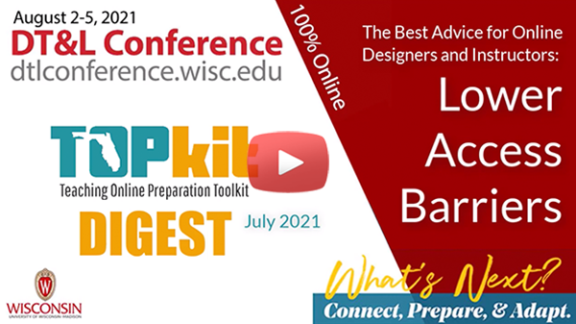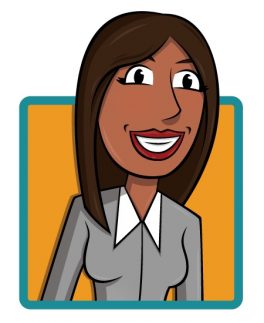Bringing TOPkit Digest to You
|
|
Contents of this Digest:
- Video Tip: Advice for Online Designers - Lower Access Barriers
- Top Tips: Become an Expert Online Designer
- From the Community: What’s Next for Online Design & Teaching
- More From the Community: Empowering Faculty Development Professionals
- Ask ADDIE - Getting Started with Digital Badges
- Top Community Topics
|
|
Advice for Online Designers: Lower Access Barriers
Best practices from the University of Wisconsin-Madison's Distance Teaching & Learning Conference |
|
|

|
|
Based on more than 35 years of presentations, speeches, workshops, and research sessions at the University of Wisconsin-Madison's Distance Teaching & Learning (DT&L) annual conference, this video shares a “step zero” that underlies every best practice for online and technology-mediated learning: lowering access barriers. Students drop out, stop out, and fail to meet their potential when they encounter technological, cultural, systemic, or practice-based barriers. By working to lower such barriers, we create the largest and most positive impact for our online learners’ success. Sign up for the virtual 2021 DT&L Conference.
|
|
Become an Expert Online Designer with Tips from the Experts at DT&L!
A Practical Preview of the Best “What’s Next” Ideas from the 2021 UW-Madison Distance Teaching & Learning Conference |
|
|
|
Worldwide, experts and leaders in the online and technology-mediated education field have come into sudden prominence and demand because of the emergency shift to remote instruction caused by the COVID-19 pandemic. Now that everyone has experienced the same needs for academic rigor within flexible tools, schedules, and interactions, we’re all wondering “what’s next?” "What’s next?” is the theme for the 2021 Distance Teaching & Learning conference from the University of Wisconsin-Madison, to be held online August 2-5, 2021. We caught up with some of the keynote and invited speakers to collect their biggest “what’s next” tips for online and tech-mediated learning in the After Times of the next five years.
|
|
|
|
|
|
|
|
|
#1 - Champion the Move from Access to Equity. Dr. Gloria Niles at the University of Hawai’i–West O’ahu says that our online learners often experience intersectional disadvantages through structural and institutional hetero-patriarchy, racism, ableism, capitalism, and settler colonialism. Relying on learners to speak up and request individual changes puts the burden in the wrong place. Guide faculty to take notice if many students are asking for individual changes, accommodations, or affordances in their online offerings. Guide them to think instead of how to lower barriers systemically in the design of their interfaces and interactions, using frameworks like universal design for learning, or UDL.
|
|
#2 - Build Care Everywhere. Dr. Maha Bali from the American University in Cairo is a champion for shifting our online design and teaching away from undervalued, unrewarded, affective labor that drains and exploits us. Instead, we should learn how to create space for us to pursue labors of care and support that energize and fulfill us. To go beyond just the feeling of care and support, learn how to foster communities of care at all levels that help to sustain us in technology-mediated environments.
|
|
#3 - Online Isn’t Just the LMS. Dr. Shaun Iles at Mohwak College has been using the learning management system for years in order to have a “home base” for the content and interactions in his online and technology-mediated courses. He has also been using communication, storage, and annotation tools beyond the LMS—his latest is Discord—to foster a greater sense of learner engagement, agency, and belonging. | |
#4 - Show Faculty that the Text is Their Friend. Dr. Jenae Cohn at Cal State Sacramento is the author of Skim, Dive, Surface: Teaching Digital Reading. It’s a common challenge that our learners don’t do the readings to prepare for engagement in our technology-mediated spaces and activities. Guide faculty to apply recent research from cognitive psychology, neuroscience, learning science, composition theory, and the scholarship of teaching and learning in order to frame, scaffold, and implement effective digital content throughout their courses—ones that learners will make time to complete.
#5 - Promote Design to Foster Community Interactions, like Hashtag #Awesome Discussions. Dr. Travis Thurston with Utah State University is all about engaging learners in authentic ways. His concept of “digital powerups” is an example of designing courses for fostering community interactions. It provides online learners with the reason for engaging in discussion or practice by using hashtags to create references beyond the LMS discussion tool, expand the formats that learners can use to show their thinking, and open scholarly conversation to mashup culture. Learn more by listening or reading Travis’s conversation on the Teaching in Higher Ed podcast. #6 - Offer the Perspective that Online Can Be Better than In-Person. Dr. Siân Bayne and Dr. Jeremy Knox at the University of Edinburgh are co-authors of The Manifesto for Teaching Online, a series of position statements about what online education could be. Among their ideas about the politics, ethics, and purpose of online learning, one piece of advice stands out: “Online can be the privileged mode. Distance is a positive principle, not a deficit.” In practical terms, we’ve been designing online experiences for decades as “less than” simulacra of face-to-face interactions. We should flip our perspective and start thinking about what we can do together online that isn’t even possible in a real-time classroom environment. We can move from “good enough” by focusing on faces, places, and spaces to create better ways to do teaching and learning.
|
|
Dive Deeper into What’s Next for Online & Teaching Design
Resources from the 2021 Distance Teaching & Learning Conference Speakers |
|
|
|
You may be interested in hearing more from leaders in the field of online education. Here are further-reading resources from some of these voices.
|
|
- Bishop, MJ. (2012). Instructional message design: Past, present, and future relevance. In J.M. Spector, M.D Merrill, J. Elen, & M.J. Bishop (Eds.), The Handbook of Research for Educational Communications and Technology (4th ed.). New York: Springer. http://cecs6200.pbworks.com/w/file/fetch/70349818/Bishop Past Present Future.pdf.
- Gruber, J. (2020). Mental health and clinical psychological science in the time of COVID-19: Challenges, opportunities, and a call to action. American Psychologist. https://pubmed.ncbi.nlm.nih.gov/32772538/.
- Veletsianos, G. (2021). What has COVID-19 taught us about the barriers to online education? Policy Options. https://policyoptions.irpp.org/magazines/april-2021/what-has-covid-19-taught-us-about-the-barriers-to-online-education/.
|
|
Empowering Faculty Development Professionals
|
|
|
|
Although faculty receive many opportunities to engage in professional development, those professionals who ensure that faculty have just-in-time development experiences have little opportunity to glean tips for themselves. These are the same professionals who recently expended much of their effort to ensure that faculty have the tools they needed to transition their courses to online or blended modalities in the wake of the COVID-19 crisis. Likely feeling depleted, these faculty development professionals need a reboot to re-energize their enthusiasm. Read more on tips for planning, developing, and evaluating faculty development.
|
|
|
Amanda E. Major, EdD, PMP, CPLP, Instructional Designer and Project Manager, Center for Distributed Learning, University of Central Florida (Amanda.Major@ucf.edu)
|
|
Getting Started with Digital Badges
Recognize Accomplishments Acquired through Learning Experiences |
|
|
|
 | |
Dear ADDIE,
There’s been a lot of talk at my college about using digital badges in our online courses. I’m not sure I understand why or how our faculty would use them. We don’t have an institution-wide infrastructure that supports badging. What advice can I give my faculty who are interested in trying them? Signed, We don’t Need no Stink’n Badges
|
|
Content Coordinator and Contributor
Thomas J. Tobin, PhD, MSLS, MOT, PMP, CPACC; Program Area Director for Distance Teaching & Learning University of Wisconsin-Madison (thomas.tobin@wisc.edu) @ThomasJTobin Developer and Editor
Bren Bedford, MNM, Web Project Analyst, Center for Distributed Learning, University of Central Florida
Editor
Samantha Richardson, B.A. English, Communications Specialist, Pegasus Innovation Lab, Center for Distributed Learning, University of Central Florida
|
|
|


